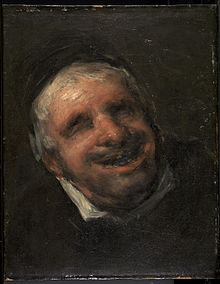El Tío Paquete
El Tío Paquete is the title of a painting by Francisco de Goya that was created between 1819 and 1824. The picture belonging to Goya's group of works of the "Black Paintings" is in the Museo Thyssen-Bornemisza in Madrid.
Description and background
The work El Tío Paquete measures 39 × 31 cm in portrait format. It is executed in the painting technique oil on canvas ; it is listed in Goya's catalog raisonné in José Gudiol 1970, no. 723; in Gassier and Wilson 1971, no. 1631 and in De Angelis 1974, no. 640. In the Museo Thyssen-Bornemisza it has the inventory number 165 (1935.8).

Goya marked the back of the painting with the inscription El célebre ciego tijo ( The famous completely blind man ). According to this, this picture is the portrait of the old Paquete, a blind beggar who usually sat on the steps of the church of San Felipe el Real and was famous for his guitar-accompanied singing. In the impasto application of paint, in the free brushwork and in the dark coloring , this painting is directly comparable with Goya's “Black Paintings”; Thus the creation of the picture can be dated to the years 1819 to 1824.
Provenance
Provenance : The painting was originally in the possession of Mariano Goya y Goicoechea (1806–1874), the artist's only grandson. It finally ended up in the collection of the Comte de Doña Marina, Marqués de Heredia in Madrid. In his possession it was shown at the Goya exhibition in Madrid in 1900. The painting was transferred to the Rohoncz Castle Collection in 1935 , acquired as part of the Thyssen-Bornemisza Collection in Lugano ; it is now located in the Museo Thyssen-Bornemisza in Madrid, which opened in 1992 .
reception
The art historian Elsbeth Wiemann (1989) judged: “The physiognomy of the blind is grasped in relentless openness, but without caricaturing intent. The intensity of the work is based precisely on the fact that Goya endowed the face with human dignity - regardless of its grotesque features. "
Web links
Individual evidence
- ↑ José Gudiol: Goya. 1746-1828 . [Biography, Analytical Study and Catalog of his Paintings. Translated from the Spanish by Kenneth Lyons]. New York. Tudor Publishing Company., 1971
- ^ Gassier, Pierre / Wilson, Juliet: Francisco Goya. Life and work . Friborg, Office du Livre 1971
- ↑ Angelis, Rita de: La obra pictorica completa de Goya, Editorial Noguer Barcelona Madrid, 1974
- ↑ Fundación de Aragón: El tío Paquete
- ^ A b c d Albert Boesten-Stengel, Bernhard August Rave, Elsbeth Wiemann: Masterpieces from the Thyssen-Bornemisza Collection: Paintings from the 14th to 18th centuries ; Staatsgalerie Stuttgart, December 10, 1988 - March 5, 1989 [an exhibition by the Thyssen-Bornemisza Foundation and the Stuttgart State Gallery ].
- ↑ Tio Paquete in the database of the Museo Thyssen-Bornemisza
